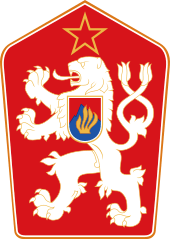Demographics of Czechoslovakia
Population (1991): 15.6 million, of which Czechs 62.8%, Slovaks 31%, Hungarians 3.8%, Romani people 0.7%,[1] Silesians 0.3%. Ruthenes, Ukrainians, Germans, Poles and Jews (the post-Holocaust community) made up the remainder of the population.
| Part of a series on the |
| Czechoslovak Socialist Republic |
|---|
 |
|
History |
Population growth rate 2.7% in 1985, 1.7% in 1990, with a decreasing tendency – more noticeable in the Czech Republic than in Slovakia. In 1989 life expectancy was 67.7 years for men and 75.3 years for women. About 23.1% of the population was under the age of 15, and 19% was over the age of 60.
The population density in 1986 was approximately 121 persons per square kilometer. The most densely settled geographic region was Moravia, which had around 154 persons per square kilometer. The figure for Bohemia was around 120, and for Slovakia, around 106. The major cities and their estimated populations in January 1986 were as follows:
- Prague (ČSR) 1.2 million (1.85 million in Metropolitan area)
- Bratislava (SSR) 417,103
- Brno (ČSR) 385,684
- Ostrava (ČSR) 327,791
- Košice (SSR) 222,175
- Plzeň (ČSR) 175,244
Czechoslovakia remained essentially a society of small cities and towns, in which about 65% of the population were classified as urban dwellers.
Czechoslovakia's ethnic composition in 1987 offered a stark contrast to that of the First Republic (see History). The Sudeten Germans that made up the majority of the population in border regions were forcibly expelled after World War II, and Carpathian Ruthenia (poor and overwhelmingly Ukrainian and Hungarian) had been ceded to the Soviet Union following World War II. Czechs and Slovaks, about two-thirds of the First Republic's population in 1930, represented about 94% of the population by 1950 With Hungarians the Third largest group.
The aspirations of ethnic minorities had been the pivot of the First Republic's politics. This was no longer the case in the 1980s. Nevertheless, ethnicity continued to be a pervasive issue and an integral part of Czechoslovak life. Although the country's ethnic composition had been simplified, the division between Czechs and Slovaks remained; each group had a very similar history, but sometimes divergent aspirations.
From 1950 through 1983, the Slovak share of the total population increased steadily. The Czech population as a portion of the total declined by about 4%, while the Slovak population increased by slightly more than that. The actual numbers did not imperil a Czech majority; in 1983 there were still more than two Czechs for every Slovak. In the mid-1980s, the respective fertility rates were fairly close, but the Slovak fertility rate was declining more slowly.
For details on ethnic groups see also:
- History of Czechoslovakia (1918–1938)
- History of Czechoslovakia (1948–1989)
Religious affiliations in 1930:[2]
Roman Catholic 73.5%
Protestants 7.67%
Czechoslovak Hussite Church 5.39%
Greek and Armenian Catholics 3.97%
Jews 2.42%
Orthodox 0.99%
No affiliation 5.8%
References
- de facto more – Romanies were often counted as belonging to other ethnic group, esp. Hungarians
- Culture and Customs of the Czech Republic and Slovakia by Craig Stephen Cravens, p. 35
![]()
External links
- RFE Czechoslovak Unit Open Society Archives, Budapest